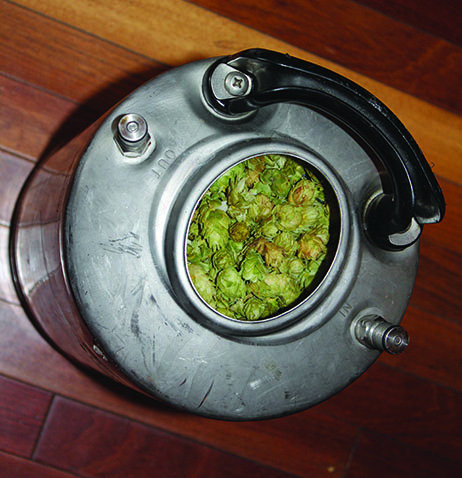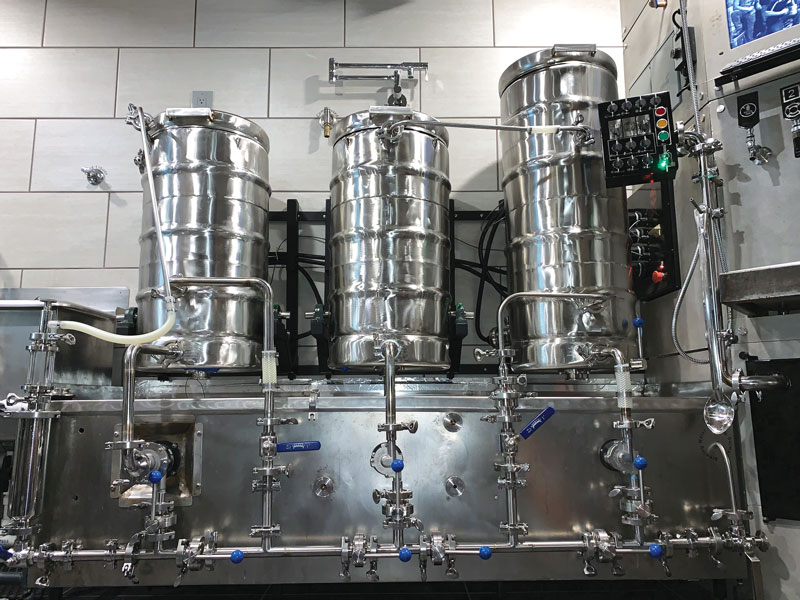Keg Hopping
TroubleShooting
Josh Jayne - West Haven, Connecticut asks,
Some questions came up in our homebrew club about keg hopping. First, will you get the same effects in a cold keg as you would a warm secondary? and if it does work, what is a good method (quantity, temperature, time frame)?

When it comes to dry hopping, there are more opinions and hotly debated explanations of what is happening than there is science. This can drive a brewer crazy, especially for those of us who really want to know why!
If you want to end up with a nice dry hop character (carboy or keg is not so critical), give the following a whirl. Add 1 to 11⁄2 ounces (28 to 42 g) of good aroma hops (I will come back to this later) to a 5-gallon (19-L) batch towards the end of fermentation. When using a keg, I suggest racking beer from your primary to the keg before fermentation has ended. The reason for this recommendation is that hops, whether pellets or cones, are little air sponges and can lead to oxidation. Adding hops to beer with active yeast helps guard against detectable oxidation. Personally, I would rather dry hop in my primary because limited contact is something that I believe in . . . this is that opinion stuff coming into play!
There has been some very helpful research coming out of Dr. Tom Shellhammer’s group at Oregon State University and one of the practical, take-home messages is that not much time is required to maximize the aroma yield from dry hopping; two days is plenty of time. And since extended dry hopping can lead to the extraction of vegetal flavors from the hop matter there is a good argument to limit the contact time. Racking your beer off of the dry hops is a good way to simply minimize these flavors. This is why dry hopping in the primary is convenient; just rack your beer into your keg and move forward as usual. Pretty simple.
You can certainly dry hop cold beer, and with the change in method you should expect some changes. One of the more notable differences is that it takes longer to extract the hop aroma oils with cold beer. Time is something that most homebrewers can accept, and the added time is not a major drawback. But there is one difference that does concern me and that is the reduced yeast activity with the cooler temperatures. Since active yeast help mop up oxygen, and dry hopping does add oxygen to beer, it logically follows that dry hopping warm beer with active yeast is less likely to result in beer oxidation than dry hopping cold beer with much lower yeast activity. This is the reason that I prefer dry hopping warm beer.
There are many new dry hopping methods being used by commercial breweries, which have been developed to address the challenges of adding large masses of hops to large fermenters. I do not believe there is any reason to use these sorts of methods when brewing at home. But there is one thing that the best hoppy beers all share that is as important to a 1-gallon (4-L) batch of beer as it is to a 50,000-gallon (190,000-L) batch of beer; hop quality.
Hop quality is subjective and not all brewers and beer consumers prefer the same sorts of hop aromas. Hop quality is also objective in the sense that hops devoid of tropical fruit and citrus aromas will not yield these aromas in a dry-hopped IPA, regardless of the hop variety name that is printed on the bag. Great hop aroma happens when you use great hops. This is truly a topic fit for an entire book, with much of the information yet to be defined.
What all brewers can do is evaluate hops before purchase and before use. If you know where hops are grown and the year the hops were harvested you can do research about the crop and the crop year. Knowing how the hops have been packaged and stored is also valuable information because great hops can be ruined if not packaged and stored properly. Smelling those hops before use is the last line of defense to prevent adding subpar hops to an otherwise great batch of beer.

